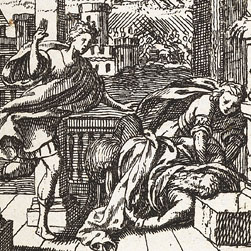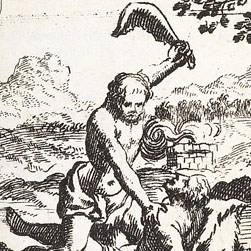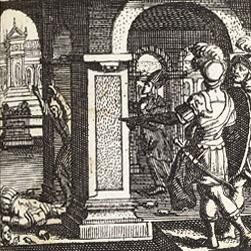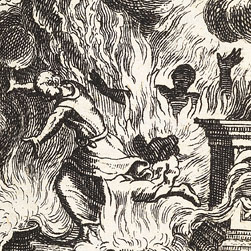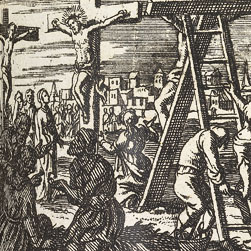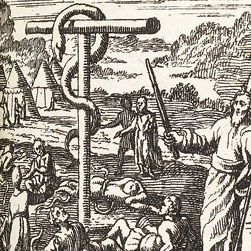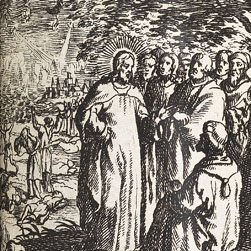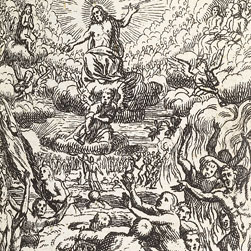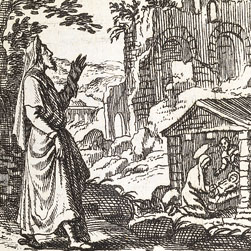In making their picture books, Christina and Magdalena Küsel compressed the Old and New Testaments into a selection of prints representing tales from each book of the Bible. A German text, probably printed separately from the engravings as letterpress, identifies the scene along with the book and chapter of the Bible from which it derives. There are 132 prints in the Old Testament and 131 prints in the New.
‘God Have Mercy On Me, Sinner That I Am’ (Luther)
Man is predestined to sin. The men and women of the Old Testament were not saints to be worshipped and revered. Luther insisted on their human failings, their need for forgiveness from God, and if they were protected and sustained by God it was not because of their own merits, but because of the will of God and consequently the strength of their faith. Thus the histories of the Old Testament became manifestations of Luther’s doctrine of salvation not through good works, but through faith alone: sola fide. There is nothing heroic in the Küsels’ treatments of the biblical figures. Images of murder, grief and sorrow abound, for example: The Death of Eli (I Samuel IV); the Murder of Abel (Genesis IV); and Anger of the Lord against Israel (II Samuel XXIV). The drama of divine retribution is depicted in the Death of Nadab and Abihu (Leviticus X).
The Importance of Humility
According to Lutheran theology, following the law does not earn one salvation and good works do not eradicate sins – it is not the person who performs works and worships images who is saved; it is the one who admits sin and humbly prostrates himself before God. Therefore, the figures we see in the Old Testament miniature engravings demonstrate great humility and kneel in reverence to the God who cannot be seen but only heard, as indicated by the Hebrew script in the prints representing episodes in Genesis IX, Genesis II and Exodus III and in Christ’s transfiguration in the New Testament. Detailed facial expressions and animated gestures, perhaps surprising on such a scale, convey awe and wonder.
Perhaps the greatest indicator of Protestant sympathies lies in Merian’s and the Küsels’ depiction of Daniel chapter 7 which follows the Protestant eschatological theory (doctrine concerning the final events in the history of humankind) of the “four monarchies” with its harrowing depiction of the fourth Beast and its little horn, representing Rome and papal tyranny respectively. The Küsels’ Beasts, in contrast to Merian’s depiction, are altogether removed from the context of Daniel’s dream and the ‘fourth Beast’ is made the most prominent and noticeable feature of the engraving, boldly staring directly out at the reader.
Christ as Saviour of the World
The first plate introduces the context for the New Testament, detailing Christ as Saviour of the world (Salvator Mundi) .The triumphant Christ depicts how faith in Him defeats sin and death in order to redeem mankind. In contrast to the fall of Adam in the Old Testament, the figure of the Saviour proclaims his coming, his victory over sin, death and hell, and how faith alone breaks the chains of sin, in accordance with Luther’s theology. Together the images facilitate the double harvest of two different kinds of fruit: implicitly typological, they call to mind the sins plucked by Adam and Eve from the Tree of the Knowledge of Good and Evil and equally recall the absolution of sins from the Tree of Life, or the Cross of Christ.
Divine Judgment and Salvation
Divine judgment and salvation are emphasised in many of the Küsels’ prints, as in Matthew XXIV and XXV. For the portrayal of Matthew XXIV, instead of the prophecy about the destruction of the ‘Temple’ at the end of days, the wrath of the Divine is directed towards the Catholic churches of what could be Augsburg, discernible in the background. In addition, strong emphasis is placed on the torment of the damned in Matthew XXV, to remind readers of the ever-present dangers of falling into sin.
Prominence is also given to selected episodes from the Acts of the Apostles, detailing the conversion of Paul, the coming of the Holy Spirit and the Apostles’ mission, as well as apocalyptic scenes from the Book of Revelation. As well as drawing out the distinction between the Law of Moses and the Gospel, the Old Testament is also illustrated as foreshadowing events in the New. For example, the vision prophesied by Micah that the Messiah would be born in the town of Bethlehem, is envisaged by the Küsels as Christ’s Nativity.
Back to German Miniature Picture Bibles

